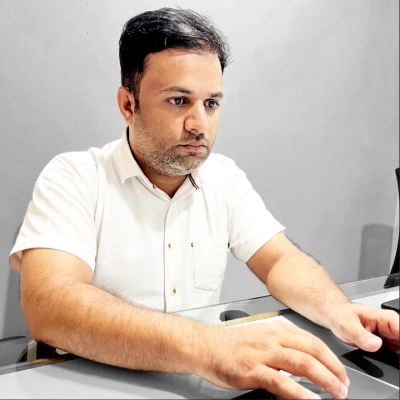10 Ways to Help Clients Identify Their True Competitive Advantage in a Crowded Marketplace
Businesses seeking to stand out in crowded markets need practical strategies for identifying authentic competitive advantages. Industry experts have shared proven methods that help companies uncover their unique value proposition beyond superficial differentiators. These actionable approaches enable businesses to transform customer insights, overlooked market opportunities, and internal strengths into sustainable competitive advantages.
Map Customer Feedback to Uncover True Value
Instead of asking clients what they think makes them special, I focus on how their audience actually perceives them. With a client in the crowded SaaS space, we took an outside-in approach rather than the usual feature comparison analysis.
We systematically mapped customer feedback, engagement patterns, and content interactions to uncover what truly mattered to their users. The revealing insight? Their customers valued trust and guidance more than the software's technical capabilities.
This became the cornerstone of their positioning strategy. Unlike traditional methods that rely on internal assumptions or competitor feature analysis, we let actual market data reveal their competitive advantage. The result was messaging that genuinely resonated with their audience and created clear differentiation in a space where most companies were saying the same things.

Find Differentiation in Problems Competitors Ignore
I made my clients stop talking about what they thought they were great at. Because, mostly, customers don't show value to the CEO's vision board or brand value. So, I decided to research more about customer complaints and competitor reviews. And the actual truth that is ignored by the brands. That's where the real differentiation shows up, in the gaps nobody else bothers to fix. Traditional methods usually mean running bland surveys that ask people to rank features on a scale of one to five, producing data so beige it could be used as wall paint. My approach looked more like investigative journalism: reading between the lines, watching how buyers actually behave, and finding the one thing they value but competitors consistently screw up. The "advantage" wasn't another bullet point on a features list. It was an experience shift. The process worked because it stopped chasing validation and started hunting for contradictions. Truth hides in the mess, not the PowerPoints.

Conduct Reverse Perception Audit for Authentic Advantage
One approach I've found particularly effective is what I call the "reverse perception audit." Instead of starting with internal assumptions about strengths, we begin by listening—really listening—to customers, competitors' clients, and even employees. The goal is to uncover how the brand is actually perceived versus how it thinks it's perceived.
I used this method with a mid-sized food brand struggling to differentiate itself in a saturated market. Traditional methods might have focused on market analysis, product features, or pricing strategy. Instead, we conducted interviews, surveys, and social listening to capture unfiltered opinions. What emerged wasn't what the leadership expected—the brand's strongest advantage wasn't its ingredient quality or pricing, but its story of local sourcing and community involvement, which resonated deeply with consumers.
From there, we reshaped messaging, packaging, and marketing campaigns around that authentic narrative. Engagement and sales both climbed noticeably within a few months.
What made this approach different from traditional methods was the focus on perception over projection. By prioritizing how others see the brand rather than how the company sees itself, we uncovered a competitive advantage that was both authentic and defensible—a foundation that traditional feature-based analysis might have completely overlooked.

Focus on Experience Beyond Similar Products
One approach I've used to help a branding merchandise client identify their true competitive advantage was to shift the focus away from the products themselves and look closely at the experience they were creating around them. In this industry, almost everyone sources from the same vendors, which means the end products can look nearly identical. So instead of asking "What do you sell?" we dug into "How do you deliver it—and how does that make people feel?"
Through conversations with their team and customers, we uncovered that their real edge wasn't the merchandise — it was the highly personalized service and thoughtfulness behind each project. They weren't just handing out branded swag; they were curating tailored experiences that reflected each client's culture and values.
This process differs from traditional competitive analyses because rather than benchmarking SKUs and pricing, we focused on emotional touchpoints, storytelling, and delivery moments that competitors overlook. That shift helped them confidently own their positioning as a boutique, relationship-driven partner — not just another vendor.

Discover Human Strengths After AI Takes Over
When I worked as an AI consultant, I helped clients discover their true competitive advantage by asking a different question: "What can you do that others can't once AI takes over the repetitive work?"
Instead of starting with SWOT charts or competitor benchmarks, we analyzed their workflows to see where AI could free up time, reduce cost, or generate insights faster. That shift usually revealed their hidden strengths the human elements that actually mattered, like customer empathy, creative judgment, or brand relationships.
For one client, automating customer support with an AI receptionist showed that their real edge wasn't response speed; it was how personal and reassuring their tone was. We then built their messaging around that.
Traditional methods look outward, at competitors. This process looked inward, at how AI could amplify what already made them special.

Leverage Local Presence as Lasting Advantage
Helping a client identify their "competitive advantage" in a crowded marketplace is simple. The one approach we use is to ignore what everyone else is doing and focus entirely on the biggest failure point of the industry: permanence. Our true advantage is that we are a local business that is not going anywhere.
The traditional discovery process looks at pricing and services. We look at the competition's biggest failure—a lack of accountability. My insight was that our biggest competitive edge is the owner's physical presence and the promise of a long-term guarantee. Most of our competitors are "storm chasers" who disappear when the work is done.
We use this to our advantage. Instead of spending money on generic ads, we invest in hyper-local neighborhood sponsorships and clear communication that we are a Houston-based business and are not going anywhere. We sell the peace of mind that comes from knowing the contractor lives locally and will be here next year if there is a problem.
The key lesson is that in a crowded market, your greatest advantage is your stability. My advice is to stop trying to compete on price and instead make your local commitment your strongest sales tool. Let your competitors chase the quick buck. You focus on building a reputation that lasts longer than the roof.
Examine Customer Stories to Reveal Hidden Strengths
One approach I've found effective is to start by looking at the client's existing strengths through the lens of their audience, not their competitors. Instead of asking "Who are your rivals?" we ask, "Why do your customers choose you, really?" We dig into the stories, frustrations, and successes that surround the client's business.
This often uncovers advantages that are invisible in a traditional market analysis, things like a genuinely intuitive process, a team's ability to adapt quickly, or a small detail in the product that customers can't get anywhere else.
This differs from traditional methods because it doesn't start with spreadsheets, trends, or benchmarking. Those tools are helpful later, but early on, we focus on discovery and reflection. Clients often think they know what sets them apart, but when they hear patterns emerge from their own customers' experiences, it clicks.
Suddenly, what they were taking for granted becomes a core differentiator. Once this advantage is clear, every decision aligns with it. The client no longer chases the market; they create a space that only they occupy, and that's what makes them stand out naturally.
Start With Clarity First Before Market Analysis
One approach I use to help clients uncover their true competitive advantage is what I call a Clarity First Audit.
Traditional consulting often starts with market data, competitive analysis, and financial metrics. Those are important, but they tend to produce sameness. Everyone is looking at the same numbers, so everyone ends up chasing the same "differentiators." The result? Another bland positioning statement that could belong to any competitor.
My Clarity First Audit flips the order. Instead of starting with the outside market, I start with the founder or leadership team. I ask questions like:
What do you want to be known for if tomorrow were your last day running this company?
What are the decisions you've made (even the unpopular ones) that show your true values?
Where have you said no, and what does that reveal about what really matters?
Once that clarity is articulated, then we bring in the market and audience data. The difference is profound: instead of bending themselves to fit a trend, founders see how their unique DNA intersects with what the market actually needs. That intersection is where their true competitive advantage lives.
One client, for example, believed their advantage was technical expertise because that's what their competitors bragged about. Through the audit, we uncovered that their real differentiator was radical accessibility — they were the only ones demystifying the process for non-technical buyers. Once we reframed their messaging around "accessibility over jargon," they saw immediate traction: faster sales cycles, stronger word-of-mouth, and prospects saying, "I finally understand this, and that's why I want to work with you."
Users respond to this approach with relief. They don't feel like they're trying to wear someone else's clothes anymore. Instead, they feel seen, and their customers feel the same.
The lesson I've learned in all of this is that competitive advantage isn't found in what you copy; it's found in what you clarify. That's why I always say, "Clarity Before Everything."

Transform Operational Data Into Competitive Stories
In our industry, competing in a crowded marketplace is a real challenge. Everyone claims quality. We knew we couldn't just chase numbers; we had to be smarter about it.
The approach we used to identify a client's true competitive advantage was to conduct a Reverse Operational Audit of the Customer Experience. The real value isn't in traditional market research; it's in how we use our internal data. We don't just look at a number. We look at the actual customer's problem and their "story."
This process differed from traditional methods by forcing the client's Marketing team to get out of the "silo" of generic claims. We analyzed our competitors' top customer complaints (their operational failures) and cross-referenced them with our own heavy duty fulfillment logs. This revealed that the true advantage was our specialized "Order-to-Delivery Cycle Time" for OEM Cummins parts, backed by a clean 12-month warranty record—a defensible operational asset.
This simple, manual process has completely changed our approach. We are no longer just competing with a number. We are competing with a strategy. Our marketing is now more targeted and more effective.
My advice is simple: the best way to identify competitive advantage is to stop looking at the numbers and start looking at the story. The best way to beat a competitor is to understand them, and your internal operations data is a goldmine of information.

Build Unique Advantage Through Employee Experience
When helping a client identify their true competitive advantage, our approach starts with listening. Often, companies overlook the value already within their organization: their people, their culture, and how they communicate their purpose. At Sociabble, we guide clients to uncover what makes their employee experience unique and how it translates into brand advocacy. What I've observed is that, when a company defines its advantage through its own people, it builds a differentiation that competitors can't replicate.



